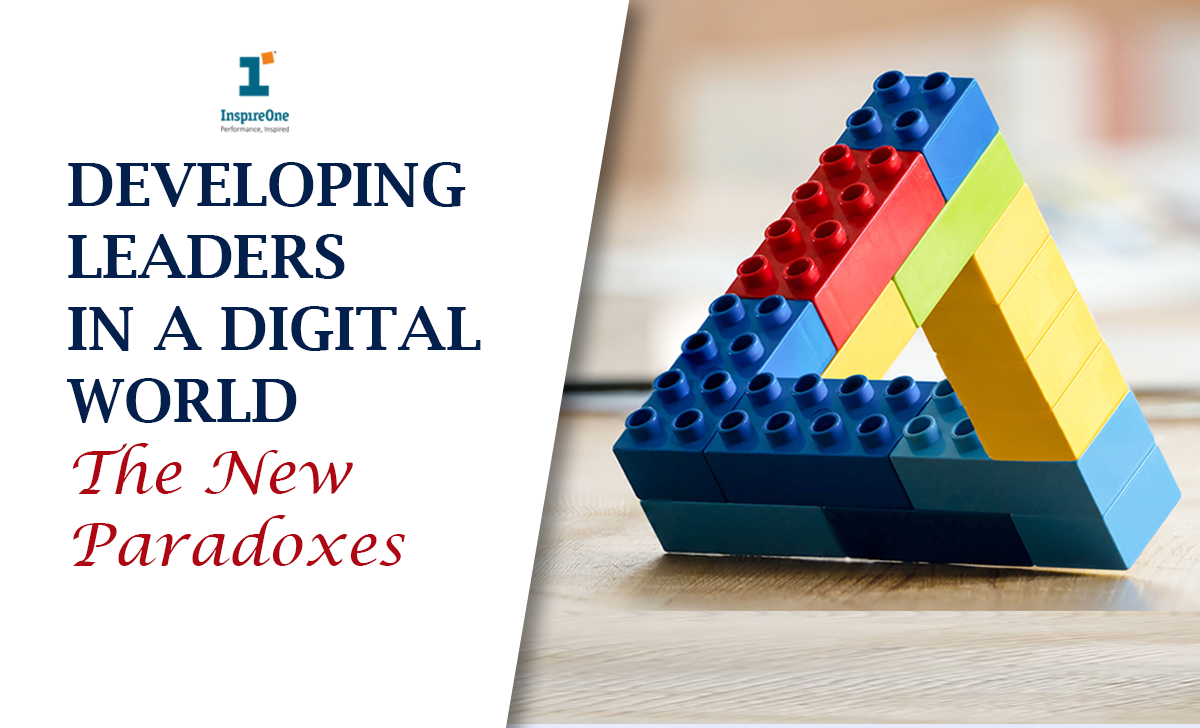This blog is a part of our two-blog series on the topic “Leadership in the Digital World”. In our first blog, we focused on the mindset and competency shift required by the leaders in the VUCADD business environment. In this blog we will talk about, what InspireOne believes will be some of the new paradoxes that leaders will have to manage in the digital world. This is substantiated by recent research and studies in the same area.
The business environment is constantly evolving, and it has fast moved from being a VUCA to a VUCADD world. Leaders have always faced the daunting task of managing and handling paradoxes. On one hand they need to keep pace with the globally evolving world and on the other hand they also need to step back and take stock of their processes and resources in place. With the advent of digitalization, the paradoxes have broadened to the digital space as well.
The first paradox is digital transformation vs digital disruption. Deloitte’s fourth annual study has shown that there is a 16% increase in productivity when there is continuous focus on streamlining process and continuous improvement. Brian Solis, a principal analyst at Altimeter Group defines digital transformation as: “The realignment of, or new investment in, technology and business models to more effectively engage digital customers at every touchpoint in the customer experience lifecycle.” Being digitally enabled as an organization means to bring about the transformation of moving from traditional ways of doing business to adopting fast paced and technologically advanced ways of delivering business.
David L. Rogers defines digital disruption as: “… disruption happens when an existing industry faces a challenger that offers greater value to the customer in a way that existing firms cannot compete with directly.” A great example of digital disruption is Uber who with its technologically advanced app-based tool genuinely disrupted the traditional taxi services. It gave greater value and ease of use to its customers breaking down the business model of the average taxi companies
The second paradox in that leaders encounter in the digital word is agile execution vs digital awareness and intellectual knowledge. According to a Deloitte study the pace of business: speed and agility is one of the biggest differentiators (23%) between traditional business and digitally advanced business. Digital business requires people to move faster than ever before. While business digitalization means faster pace; business decision, communication and process implementation take time. Successful digital transformation is a radical process of continuous innovation and development of capabilities over time. The process of knowledge assimilation of the new technological tool, to increase one’s digital awareness and intellectual knowledge takes time too. While digital leaders need to move with agility, they are challenged by coping with digital information and knowledge assimilation.
The third paradox in the changing scenario is agility in delivering customer experience vs collaboration through diversity. New research from McKinsey describes agile companies as follows: “Agile organizations appear to be powerful machines for innovation and learning. What makes agile companies special is their ability to balance fast action and rapid change, on the one hand, with organizational clarity, stability, and structure, on the other.” It is this focus on agility in delivering customer excellence with the use of technology driven tools and innovative solutions by the customers, that is driving businesses. Some of the key organizations worth mentioning are: Uber, Airbnb, Spotify, Alibaba, Baidu, and Flipkart. However, this innovation does not happen in isolation. Harvard’s Linda Hill explains that “Innovation is not about solo genius. It’s about collective genius. It’s a journey. A type of collaborative problem solving, usually among people who have different expertise and different points of view.” Leaders will therefore need to manage the paradox of moving with agility in delivering customer excellence and collaborating different ideas and expertise, which is a relatively time-consuming process.
In this digitally disruptive world, Leaders will have to broaden their capabilities to accelerate in this digitally advancing era. Organizational strategies will need to be around managing these paradoxes. The success of organizations will be in collaborating in ways that address the duality of these situations.
References
Dave, S. (2016). Collaboration: The Foundation of the Agile BusinessCollaboration: The Foundation of the Agile Business. Retrieved from https://blogs.cisco.com/collaboration/collaboration-the-foundation-of-the-agile-business
Eric Velfre, s. v. (2017, April). THE DIGITAL TRANSFORMATION PARADOX . Retrieved from https://irishtechnews.ie/the-digital-transformation-paradox-the-five-steps-towards-enabling-modern-digital-strategies-in-enterprise-by-eric-velfre/
Gerald C. Kane, D. P. (2018). Coming of Age Digitally. Retrieved from https://sloanreview.mit.edu/projects/coming-of-age-digitally/
Hill, L. (2014). How to manage creative collaboration. Ted talk. Retrieved from https://www.ted.com/talks/linda_hill_how_to_manage_for_collective_creativity?language=en
Michael Bazigos, A. D. (2015, Dec). Why agility pays. Retrieved from www.mckinsey.com: https://www.mckinsey.com/business-functions/organization/our-insights/why-agility-pays
Kane, P. a. (2018, June). Coming of Age Digitally . Retrieved from Delloite Insights: https://www2.deloitte.com/insights/us/en/focus/digital-maturity/coming-of-age-digitally-learning-leadership-legacy.html







